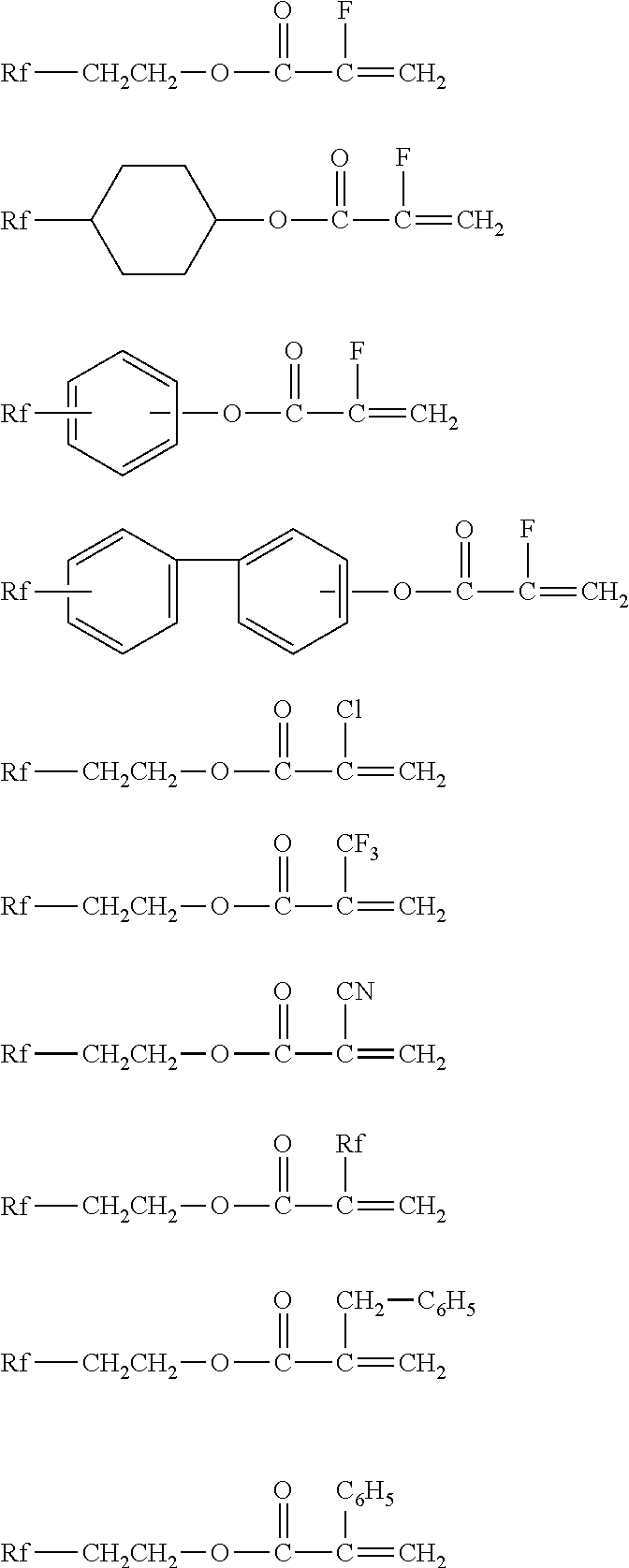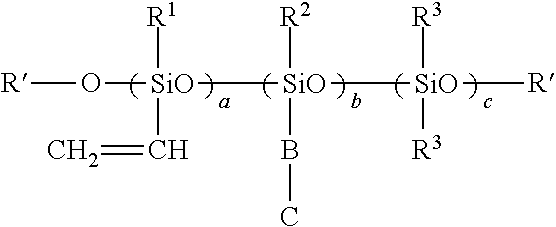Fluorosilicones and fluorine- and silicon-containing surface treatment agent
a technology of fluorosilicones and surface treatment agents, which is applied in the field of fluorosilicones and fluorineand siliconcontaining surface treatment agents, can solve the problems of affecting the effect of fabric surface harshness, reducing water- and oil-repellency, and large amount of used emulsifiers, and achieve excellent water- and oil-repellency and soil resistance to the substrate. , good feeling
- Summary
- Abstract
- Description
- Claims
- Application Information
AI Technical Summary
Benefits of technology
Problems solved by technology
Method used
Image
Examples
example 2
Comparative Preparative Example 2
[0117]Into a 1 L autoclave, CF3CF2—(CF2CF2)n—CH2CH2OCOC(CH3)═CH2 (n=2.0) (184 g), stearyl acrylate (23.1 g), glycerol mono methacrylate (4.3 g), glycidyl methacrylate (1.4 g), Mercapto Silicone 1 (Organopolysiloxane having mercapto- and amino-functional organic groups present in the molecule) (28.4 g), pure water (500 g), tripropylene glycol (79.4 g), alkyl trimethyl ammonium chloride (3.7 g), sorbitan monopalmitate (4.5 g), polyoxyethylene oleyl ether (4.5 g) and polyoxyethylene lauryl ether (18.0 g) were charged and emulsified by ultrasonic wave at 60° C. for 15 minutes with stirring. After the atmosphere of the autoclave was replaced with nitrogen gas, vinyl chloride (67 g) was injected. Then, 2,2′-azobis(2-amidinopropane) dihydrochloride (2.2 g) was added and the reaction was conducted at 60° C. for 5 hours to give an aqueous dispersion of a polymer.
example 3
Comparative Preparative Example 3
[0118]Into a 1 L autoclave, CF3CF2—(CF2CF2)n—CH2CH2OCOC(CH3)═CH2 (n=2.0) (184 g), stearyl acrylate (23.1 g), glycerol monomethacrylate (4.3 g), glycidyl methacrylate (1.4 g), pure water (500 g), tripropylene glycol (79.4 g), alkyl trimethyl ammonium chloride (3.7 g), sorbitan monopalmitate (4.5 g), polyoxyethylene oleyl ether (4.5 g) and polyoxyethylene lauryl ether (18.0 g) were charged and emulsified by ultrasonic wave at 60° C. for 15 minutes with stirring. After the atmosphere of the autoclave was replaced with nitrogen gas, vinyl chloride (67 g) was injected. Then, 2,2′-azobis(2-amidinopropane) dihydrochloride (3.6 g) was added and the reaction was conducted at 60° C. for 5 hours to give an aqueous dispersion of a polymer.
example 4
Comparative Preparative Example 4
[0119]Into a 1 L autoclave, CF3CF2—(CF2CF2)n—CH2CH2OCOC(CH3)═CH2 (n=2.0) (204 g), stearyl acrylate (25.6 g), N-methylol acrylamide (6.4 g), 3-chloro-2-hydroxypropyl methacrylate (1.5 g), pure water (486 g), tripropylene glycol (88 g), alkyl trimethyl ammonium chloride (3.4 g), sorbitan monopalmitate (4.6 g), polyoxyethylene oleyl ether (4.9 g) and polyoxyethylene lauryl ether (20.0 g) were charged and emulsified by ultrasonic wave at 60° C. for 15 minutes with stirring. After the atmosphere of the autoclave was replaced with nitrogen gas, vinyl chloride (67 g) was injected. Then, 2,2′-azobis(2-amidinopropane) dihydrochloride (2.2 g) was added and the reaction was conducted at 60° C. for 5 hours to give an intermediate aqueous dispersion of a polymer.
[0120]To the intermediate dispersion (15 g), added was amino-modified silicone oil (SF8417 manufactured by Dow Corning Toray Silicone Co., Ltd.) (0.23 g). The mixture was stirred for 1 hour to give an aqu...
PUM
| Property | Measurement | Unit |
|---|---|---|
| weight % | aaaaa | aaaaa |
| crosslinkable | aaaaa | aaaaa |
| oleophobicity | aaaaa | aaaaa |
Abstract
Description
Claims
Application Information
 Login to View More
Login to View More - R&D
- Intellectual Property
- Life Sciences
- Materials
- Tech Scout
- Unparalleled Data Quality
- Higher Quality Content
- 60% Fewer Hallucinations
Browse by: Latest US Patents, China's latest patents, Technical Efficacy Thesaurus, Application Domain, Technology Topic, Popular Technical Reports.
© 2025 PatSnap. All rights reserved.Legal|Privacy policy|Modern Slavery Act Transparency Statement|Sitemap|About US| Contact US: help@patsnap.com



